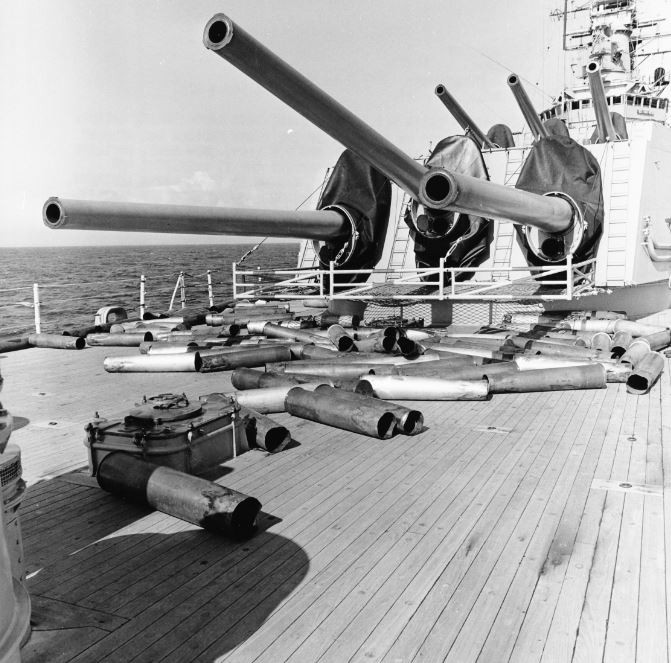Share
Connect
- Expand navigation for Beginnings Beginnings
- Why Did the U.S. Go to War in Vietnam?
- Expand navigation for Naval Advisors in Vietnam Naval Advisors in Vietnam
- Expand navigation for Passage to Freedom Passage to Freedom
- The Seventh Fleet Arrives
- Expand navigation for The Gulf of Tonkin Incidents August 2-4, 1964 The Gulf of Tonkin Incidents August 2-4, 1964
- Voices from the War
- Expand navigation for Intelligence & Special Operations Intelligence & Special Operations
- Knowing the Enemy: Naval Intelligence During the War
- Expand navigation for The Enemy The Enemy
- Expand navigation for Intelligence by Land, Sea, and Air Intelligence by Land, Sea, and Air
- Expand navigation for SEALs SEALs
- Voices from the War
- Expand navigation for Surface Navy Surface Navy
- The War at Sea
- Expand navigation for Naval Gunfire Support Naval Gunfire Support
- Expand navigation for The Big Guns The Big Guns
- Operation Market Time
- Expand navigation for Air Defense Air Defense
- Voices from the War
- Expand navigation for Air Power Air Power
- Expand navigation for From the Waves to the Skies From the Waves to the Skies
- Expand navigation for Operation Rolling Thunder Operation Rolling Thunder
- Operation Linebacker I & II
- Expand navigation for A Navy in Flames: Carrier Fires in Vietnam A Navy in Flames: Carrier Fires in Vietnam
- Helicopter Support
- Expand navigation for The Seawolves The Seawolves
- Expand navigation for Prisoners of War Prisoners of War
- Voices from the War
- Expand navigation for Riverine Operations Riverine Operations
- Expand navigation for Brown Water Navy Brown Water Navy
- Expand navigation for Operation Game Warden: Keeping Shipping Channels Open Operation Game Warden: Keeping Shipping Channels Open
- Expand navigation for Weapons Weapons
- SEALORDS
- Expand navigation for Riverine Tactics Riverine Tactics
- Voices from the War
- Expand navigation for Logistics Logistics
- Expand navigation for Ready for Battle: Supporting the War Ready for Battle: Supporting the War
- Expand navigation for Build, Repair, Defend: The Seabees in Vietnam Build, Repair, Defend: The Seabees in Vietnam
- Expand navigation for Seaborne Supplies Seaborne Supplies
- Expand navigation for From Bullets to Beans: Underway Replenishment From Bullets to Beans: Underway Replenishment
- Expand navigation for Ministry in War Ministry in War
- Expand navigation for Saving Lives Saving Lives
- Corpsman Up!
- Expand navigation for Delivering Supplies and Troops Delivering Supplies and Troops
- Voices from the War
- Expand navigation for Conclusion Conclusion
- Expand navigation for Vietnamization Vietnamization
- Expand navigation for The War Goes On The War Goes On
- Expand navigation for Operation Homecoming Operation Homecoming
- Expand navigation for Operation Frequent Wind Operation Frequent Wind
- Expand navigation for Unrest at Sea Unrest at Sea
- Expand navigation for War's End War's End
- Voices from the War
- Expand navigation for Exhibit Publications Exhibit Publications
Tags
Related Content
Topic
- Ordnance and Weapons
- Operations
- Boats-Ships--Cruisers
- Exhibits
Document Type
- Themed Collection
Wars & Conflicts
- Vietnam Conflict 1962-1975
Navy Communities
File Formats
- Image (gif, jpg, tiff)
Location of Archival Materials
- Hampton Roads Naval Museum
Author Name
Place of Event
Recipient Name

Caption:
Brass shell casings litter the deck of USS Newport News (CA 148) after a gunfire support mission. Charlie Pfeifer, an officer aboard USS Richard S. Edwards (DD 950) , remembered the incredible rate of fire maintained on gunfire support missions: “We fired so much that we re-armed probably two days out of three. So it wasn't unusual at all for us to get back on the gunline and start getting requests for fire with pallets of ammunition still sitting on the mess decks to be struck down into the magazine. You know, you do what you have to do.” (Naval History and Heritage Command)
The Big Guns
Vietnam's long, narrow shape (especially in the North) was ideal for naval gunfire support. Cruisers and destroyers targeted inland positions through North and South Vietnam. Armed and ready, with the ability to refuel and resupply at sea, naval vessels maintained an impressive rate of fire. During the war's high point in 1968, Seventh Fleet ships fired 900,000 rounds at the enemy near the DMZ. In 1972, USS Oklahoma City (CLG 5) fired 1,000 rounds in just one night.
- Accessibility/Section 508 |
- Employee Login |
- FOIA |
- NHHC IG |
- Privacy |
- Webmaster |
- Navy.mil |
- Navy Recruiting |
- Careers |
- USA.gov |
- USA Jobs
- No Fear Act |
- Site Map |
- This is an official U.S. Navy web site


